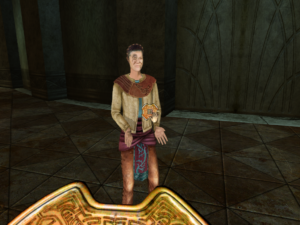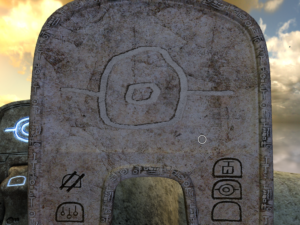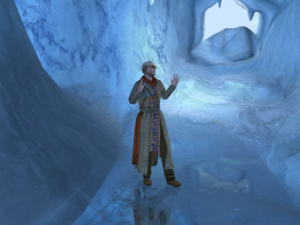I’m in chapter 7 (out of 10), and I’ve got most of the backstory by now — some of it from conversation, some from visions in dreams, some from physical evidence. The game provides plenty of redundancy in presenting information, so other players will have discovered things by different means — and in different orders. Let there be spoilers.
Basically, it all comes down to sentient alien trees that need my help. Normally, these trees bond psychically with humanoids from their own planet, effectively providing the trees with the advantages of eyes and hands. But these particular ones, the survivors of a spaceship crash, have been stranded without a host. Until Progue showed up, that is.
Progue used to be a “wayfarer” like the protagonist, although the art that moved him was sculpture rather than painting. He came to the island with his two young daughters some years ago, leaving behind the world where his wife died. The daughters, both wayfarers as well, departed the island when Progue became strangely obsessed with building strange technological devices, driven by the whispers of the trees.
Mental contact with the trees ultimately drove Progue mad. The trees claim that this is was the result of misunderstanding — Progue wasn’t familiar with the concept of trees that put thoughts in your head, and the trees weren’t used to humanoids who aren’t familiar with that concept, so neither side was really prepared. Progue assumed for a long time that the thoughts in his head were his own, and felt terrified and violated when he realized they weren’t. One of the main ways the backstory has been revealed is through the memories revealed by the trees in my dreams, memories which I see from the point of view of Progue and his children, complete with their thoughts. Progue calls this the ultimate violation of privacy, and he has a point. The trees have had years to figure out where they went wrong, and have taken care to be more delicate this time. After all, even if they’re sugar-coating things and what they actually want is a mind-controlled slave, it’s counterproductive if the slave figures out what’s going on and starts resisting and subsequently goes on a felling spree, like Progue did.
And in fact the “mind-controlled slave” theory isn’t without support. The phone-home device that the trees used Progue to build has been hacked by another group: another colony from the same planet, but one where the humanoids survived and the trees died. They say they’re doing fine on their own, which throws the trees’ “peaceful symbiosis” claims into question, and their messages to me essentially boil down to “Don’t trust them, they’re just using you”.
Which is fair enough, but given that I’m to withhold trust, why should I trust either side? It’s very much a Sirrus and Achenar situation, or, since only one side is issuing dire warnings, perhaps more like Yeesha/Esher. (The humanoids aren’t quite as snide as Esher was, but they are snide enough for it to be a little off-putting.) Anyway, I feel like I’ll be called upon to pick sides soon. Maybe a third option will present itself. Maybe one side or the other will be turned into an unambiguous bad guy via revelation of atrocities, as seems to happen a lot in fiction involving moral decisions in an atmosphere of deceit. But probably not: a couple of chapters ago, Progue gave me this big speil about relativism, and it seems like that has to have been leading somewhere.
In the latest chapter, I found a shark stranded on land, and had the opportunity to help it get back into the water, if I so chose. Not a major plot point, just an incidental event of the sort that’s been enriching the experience throughout. In our world, there’s no way the shark would be alive at the point when I found it, hours after the event that stranded it. Since we’re in an alien biosphere here, I can accept it, but it’s still enough of a strain to make it clear that it wasn’t included solely for its literal meaning.
 Comments(0)
Comments(0)



